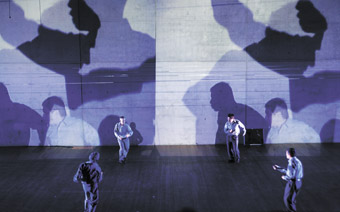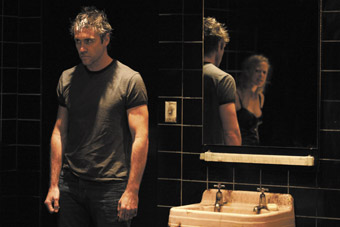the way we look
keith gallasch: the bland project;
don’t say the words

Gravity Reseach Institute, The Bland Project
photo Mayu Kanamori
Gravity Reseach Institute, The Bland Project
THERE’S NOTHING LIKE THE PLEASURE OF THEATRE THAT CONSUMES YOU AS YOU DEVOUR IT. ALAN SCHACHER’S THE BLAND PROJECT AT PERFORMANCE SPACE AND THE BARRIE KOSKY-TOM WRIGHT THE TROJAN WOMEN FOR THE SYDNEY THEATRE COMPANY WERE SUCH EXPERIENCES. I’M STILL DIGESTING THE DEMANDINGTROJAN WOMEN EXPERIENCE AS WE GO TO PRESS (READ ABOUT IT IN REALTIME 88), BUT THE BLAND PROJECT HAS BEEN PRETTY MUCH ABSORBED, SAVE FOR A DESIRE TO SEE IT AGAIN AND INGEST MORE.
the bland project
There was always a defining architectonic quality to the work of the performance company Gravity Feed, a way of working with materials to generate unusual, immersive spaces of scale—dark-suited men dancing with and manipulating door-proportioned slabs of timber into stark forms in In the House of Skin (1996) at Performance Space, the massive mobile three-metre high cardboard walls creating the spaces inhabited by performers and audience in Host (1999) in St George’s Hall, the huge metal framed red scrims constantly reconfigured around the audience in Tabernacle (1999) on the roof of a suburban carpark. But more than a mutable architecture or a living installation, was the suggestion of a potentially sacred space, of something being worked through by a silent team of men, somehow representing, containing, keeping us safe in ominous circumstances, and then releasing us.
Working as Gravity Research Institute with a range of collaborators, Gravity Feed mainstay Alan Schacher has now created The Bland Project, this time at Performance Space in CarriageWorks with four performers and an architecture created largely by video projection and mobile screens. As ever, the architecture is constantly reconfigured but this time more evanescently as images are multiplied and magnified over much of the high, long wall of the space or writ smaller as the screens travel, suspended from wires tracked from rigs each end of the space. Much of the lighting too emanates from the rigs. Again there’s the sense of a special place with its own shifting parameters and mobility, the screens largely appearing to move of their own volition.
The Bland Project too has the feel of occasion, ritual perhaps, as the bland unanimity of the four men mutates into something distinctively other over the performance’s contemplative duration. Of the same height, roughly similar build and clothing—plain shirt and trousers—the men greet us at the entrance to the theatre. They gesture as one for us to enter. In the theatre, close to the audience, hangs a large screen on which the men continue to gesture. We have time to take them in. And as the performance evolves we will look at them more and more, in greater detail, in the flesh, life size and larger on the mobile screens, huge on the wall, reading them as Asian and Caucasian, young, old, until we feel we know every feature, line, mole, chest hair (a surprising moment when this becomes an epic abstraction), a twisted nipple (writ large, intense) but never expression. The faces are masks, even when the body of each in solo moments is vibrated or racked by who knows what emotion.
Initially the men act as one. Soon they break into pairs in almost slow motion circlings. They travel with the screens, matching up with their own images. Later they will hold other screens before them as if asking us to check for correspondences. But there is one distinctive break from this massive exercise in the testing of the art of portraiture: moments when the men as one and individually seek comfort or refuge or sanctity (appearing like monks) in dark blankets that screen them from the eye of the relentless camera.
Although these enigmatic men remain in some ways bland throughout, by the end of the performance they have, through sheer physical expressiveness, through their wrought solos and instances of separation and panic, been revealed as individual, not least by the amount of attention we have paid every image of them in Sean Bacon and Michelle Mahrer’s magical mix of real time video and film. The patternings of images and their tonal texturing are bracingly pleasurable, with Sydney Bouhaniche’s swathes of light subtly transforming the space and in perfect balance with the projections.
As in any production associated with Alan Schacher there is a curious beauty about its totality; here it defies the very notion of blandness. It’s as if Schacher has looked at it and said, let’s rigorously sustain this blandness and subject it to every possible scrutiny and see what’s left—four distinctive men and an unforgettable experience rich in detail and a sense of reprieve for anyone ever labelled colourless in an age of excess like our own. The Bland Project deserves a very big audience. They will happily recognise this preoccupation with looking and estimation: after all, with the the revival of mass popular photography brought on by digitisation, never have so many been photographed so much.

Jack Finsterer, Anna Lise Phillips, Don’t Say The Words
don’t say the words
Don’t Say the Words belongs to the theatre of the floating signifier, kin to the Theatre of the Absurd and Harold Pinter’s oeuvre. Tom Holloway’s contemporary take on Clytemnestra’s murder of King Agamemnon at the end of the Trojan War has unnamed characters, an un-labelled war, a desire for vengeance for an unspecified cruelty, a murder that might not have happened or is possibly imminent, and an insistence by the soldier husband, his wife and her lover to only refer to husband and lover in the third person. While the wife admits to the murder in the first act and urges it in the penultimate scene, the men are circumspect, their quickfire quizzing of the wife oscillating between interrogation, rationalisation and rigging the narrative.
This floating world is earthed however by Holloway’s brisk, terse, highly rhythmic dialogue, replete with the violence of constant interruption and contradiction, and by hard-edged performances from Jack Finsterer, Anna Lise Phillips and Brett Stiller, all three on top of the considerable demands of the playwright’s language and director Matthew Lutton’s relentless pacing. Adam Gardnir’s meticulously realised, overtly filthy bathroom set, with its freshly applied grafitti and overflowing basin that later floods the stage, corresponds with the abject state of affairs in which the characters find themselves.
The most suspenseful and grimly funny scene is the play’s centrepiece and the one where the males are ultimately at their most evasive, and abject. The ‘war hero’, who doesn’t feel like one, and his cousin (the presumed lover) spar verbally in a bar, like old mates, testing the limits. The cousin calculatedly recalls his desire for his mate’s wife in days gone by. He pushes harder. He’s heard of a husband who maltreats his lovely wife. He directly accuses his mate of forcing anal sex on his wife while calling her by the cousin’s name: “I mean if ya wanna fuck me, mate…All you had to do was bloody—.” He admits he’s just winding up his mate, “just havin’ a lend, mate”, but is it the truth, or at least what the wife has told her lover in order to justify her infidelity? We expect violence, but the husband backs off: “Fuck this. They still got that Karaoke machine round here somewhere?…I feel like a fucking sing.”
Don’t Say The Words is an intriguing chamber piece, tautly constructed (only the wife’s solo account of the killing to an invisible detective fails to fit) and a brilliant exercise in expert dialogue writing. Although it was certainly hard to nail down all those floating signifiers and not leave the theatre without the suspicion that you weren’t taking away much more than sheer theatrical virtuosity, Holloway and Lutton managed to pull a large, fascinated audience with this brief, driven, interval-less puzzle that had something to say about the construction, in speech, of evasion and fabulation. There are words you just don’t say. It’s good to see Griffin, true to form, supporting an emerging talent like Holloway (writer of Beyond the Neck, RT82, p35) in partnership with the Tasmanian Theatre Company.
the trojan women, briefly
As we go to press, I’m just now recovering from seeing the Barrie Kosky-Tom Wright The Trojan Women for the Sydney Theatre Company, one of the most harrowing and unrelenting theatrical if grimly rewarding experiences of recent times, superbly performed by Robyn Nevin and Melita Jurisic, a trio of actor singers and an acutely engaged accompanying pianist. In a number of ways The Trojan Women is exemplary music theatre, intoned and sung. It’s a brief work, but the pain it conveys opens up a small eternity. In the same week I saw Adelaide’s The Border Project, also at the STC, do their Rock’n’Roll Highway Disaster, a kind of personalised rock concert as music theatre, dextrously realised in song, video and animation by a multi-skilled company. More later.
Gravity Research Institute, The Bland Project, director Alan Schacher, performers Ryuichi Fujimura, Teik-Kim Pok, Ari Ehrlich, Philip Mills, design Alan Schacher, Sean Bacon, video Sean Bacon, film Michelle Mahrer, composer, musician Boris Baberkoff, lighting Sydney Bouhaniche, moving screen system Russell Emerson; Performance Space, Sydney, CarriageWorks, Aug 7-9; Griffin Theatre Company, Tasmanian Theatre Company, Don’t Say The Words, writer Tom Holloway, director Matthew Lutton, performers Jack Finsterer, Anna Lise Phillips, Brett Stiller, designer Adam Gardnir, lighting Paul Jackson, dramaturg Peter Matheson, composer, sound Kelly Ryall; The Stables, July 4-26
RealTime issue #87 Oct-Nov 2008 pg. 16






